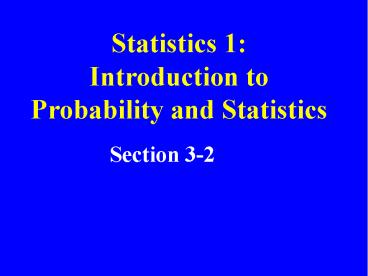Statistics 1: Introduction to Probability and Statistics - PowerPoint PPT Presentation
Title:
Statistics 1: Introduction to Probability and Statistics
Description:
Statistics 1: Introduction to Probability and Statistics Section 3-2 Chapter 3 Describing data Exploring data Comparing data Descriptive Statistics Distribution ... – PowerPoint PPT presentation
Number of Views:148
Avg rating:3.0/5.0
Title: Statistics 1: Introduction to Probability and Statistics
1
Statistics 1Introduction to Probability and
Statistics
- Section 3-2
2
Chapter 3
- Describing data
- Exploring data
- Comparing data
3
Descriptive Statistics
- Distribution
- Center
- Variation
- Position
4
Distribution
- Frequency tables
- Pictures
5
Descriptive Statistics
- Distribution
- Center
- Variation
- Position
6
Four StatisticsDescribing the Center
- Mean
- Median
- Mode
- Midrange
7
Four StatisticsDescribing the Center
- We will take them in this order
- Mid-range
- Mode
- Mean
- Median
8
The Mid-Range
- Halfway between the highest and lowest values
- (maximum minimum)/2
Mid-range Min
Max
20 40
60
9
The Mid-Range
Data 9, 23, 12, 6, 4, 17, 76
Sorted Order 4, 6, 9, 12, 17, 23, 76
- Minimum 4
- Maximum 76
- Midrange (76 4)/2 80/2 40
10
The Mode
- The most frequent value
- No mode when all values occur only once
- There are multiple modes when more than one value
is equally the most common
11
The Mean
- The average
- The center of gravity
- Calculation
- divide the total of the values by the count of
the values
12
The Mean
- Formula
- For the set
13
The Mean
- For a summary in a Frequency Table
14
The Mean
- For a summary in a Frequency Table
- Example of weighted average
- Why does this work?
- Does the calculation produce the mean of the
original data?
15
The Median
- The value in the middle of the sorted order
- if N is odd, then the median is the unique value
in the middle - if N is even, then the median is the average of
the middle 2 values
16
Symbols for Sample Statistics
- Mean
- Standard Deviation
- Variance
17
Symbols for Population Parameters
- Mean
- Standard Deviation
- Variance































